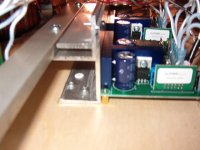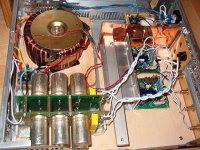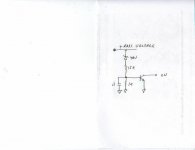....hm, which such an high input voltage big chance the UcD module will be damaged......
We have had an other customer with a complete discrete preamplifier what creates such a tremendous high DC voltage by turn of/off. Everything was blown up in the UcD module.....
But perhaps you are lucky, do you have black spots anywhere?
Regards,
Jan-Peter
We have had an other customer with a complete discrete preamplifier what creates such a tremendous high DC voltage by turn of/off. Everything was blown up in the UcD module.....
But perhaps you are lucky, do you have black spots anywhere?
Regards,
Jan-Peter
Hi!
I have just completed my 2 chnnels of UCD400 and it sounds great! However I have noticed that there are about 20mV of 388.3KHz at the output in one channel
On the other channel, it is 10mV of 400 KHz.
Is this normal? Can I eliminate it?
I have just completed my 2 chnnels of UCD400 and it sounds great! However I have noticed that there are about 20mV of 388.3KHz at the output in one channel
On the other channel, it is 10mV of 400 KHz.
Is this normal? Can I eliminate it?
Hi Arthur,
This is completly normal and is the HF carrier of the Class-D amplifier.
Nothing to worry.......
Regards,
Jan-Peter
This is completly normal and is the HF carrier of the Class-D amplifier.
Nothing to worry.......
Regards,
Jan-Peter
ackcheng said:Hi!
I have just completed my 2 chnnels of UCD400 and it sounds great! However I have noticed that there are about 20mV of 388.3KHz at the output in one channel
On the other channel, it is 10mV of 400 KHz.
Is this normal? Can I eliminate it?
Try ZAPpulse and you get much more. This is indeed normal for any Class D amp (at least as far as I know). All of them have some sort of LC filter after the switching output stage that reduces the HF components in the signal (reconstruction filter). So some HF is left always. Since the L and C in the UcD modules are quite large, it is very small in the UcD. In ZAPpulse, the L and C are smaller allowing a wider freq response up to above 100kHz (I think they state 150kHz???) leaving much more HF switching noise in the signal. Of course this may not be audible, don`t have an opinion on that.
Best regards
Gertjan
Has anyone tried building a pre-amp using these chip packages which simulate a variable resistor depending on the input applied to the chip?
I'm still harking back to how it would be quite neat to have the pre-amp section on or very near the amp module...
I'm still harking back to how it would be quite neat to have the pre-amp section on or very near the amp module...
There have been loads of experiments on speakers to determine if HF signals at speaker inputs can lead to products in the audio band. The answer is pretty much no, even with several volts worth of HF at the tweeter.ghemink said:Of course this may not be audible, don`t have an opinion on that.
@bruno or jan-peter,
Can i use the wire that is connected to /on at the ucd for on/off switching with a switch?
Grtz, Corné
Can i use the wire that is connected to /on at the ucd for on/off switching with a switch?
Grtz, Corné
Yes, you can. I, as an example, connected it with a relay, activated by the same circuit that controls the Soft-Start of the PSU. This way, I am always sure that, when the power is down, the UCD module goes down before the voltage drops, and when power is up, that there is already a reasonable amount of voltage on the PSU before the module is activated. Since a relay is essentially an electric activated switch....
Allan
Allan
Hi allan,
thnx for your input. But what kind of relay do you use?? And where does it get its power from? Because i would like to use a relay that would be triggered by my rotel rsp-1068 12v dc.
Corné
thnx for your input. But what kind of relay do you use?? And where does it get its power from? Because i would like to use a relay that would be triggered by my rotel rsp-1068 12v dc.
Corné
@Ninjanki, did you use a commercial available Softstart? Which one?
Did you just add a relay parallel over the existing one, or did you change things?
I like this approach!
Did you just add a relay parallel over the existing one, or did you change things?
I like this approach!
Mine is running hot
I have also just completed my 2 channel of UCD400. The sound is great but I am experience that the aluminiumplates that I am using for heatsinks is running real hot. I was expecting some heat but compare to my former Zappulse theese goes way over. Its more like my Aleph amps. What should I expect, and how big/much of heatsink should I use?
I have also just completed my 2 channel of UCD400. The sound is great but I am experience that the aluminiumplates that I am using for heatsinks is running real hot. I was expecting some heat but compare to my former Zappulse theese goes way over. Its more like my Aleph amps. What should I expect, and how big/much of heatsink should I use?
Attachments
Yves,
I used the ESP's project for my Soft-Start circuit. That project considers 2 relays, one connected on power-on and the second after a set time. I connected a third relay in paralell with the second relay connection, so that it would only activate after the PSU capacitors have been charged about halfway(more than 30 volts). I believe that, with this much voltage, the amplifier will go on without noises and pops. Also, when I turn the amplifier off, this third relay turns the amp module off way before the voltage on the PSU capacitors drop below any safety level. I've been able to turn on and off my amplifier without any audible noises on the speakers.
Corné,
I don't think that the 12V trigger is supposed to actually power up something like a relay, so I guess you would need to modify the soft-start circuit to use it as a power buffer to activate the relay. Maybe using something less power hungry than a relay, like a transistor or a solid state relay... Since I already had the softstart, and I am not using an external trigger, it was the easiest way for me(and I had extra 12V 10A small relays i bought but did not use on my project)... Anyway, I am not sure it is worth the trouble for you, since an idle UCD is very economic(power saving would be minimal)... Maybe to avoid pre-amp generated pops during turn-on and turno-off...
Allan
I used the ESP's project for my Soft-Start circuit. That project considers 2 relays, one connected on power-on and the second after a set time. I connected a third relay in paralell with the second relay connection, so that it would only activate after the PSU capacitors have been charged about halfway(more than 30 volts). I believe that, with this much voltage, the amplifier will go on without noises and pops. Also, when I turn the amplifier off, this third relay turns the amp module off way before the voltage on the PSU capacitors drop below any safety level. I've been able to turn on and off my amplifier without any audible noises on the speakers.
Corné,
I don't think that the 12V trigger is supposed to actually power up something like a relay, so I guess you would need to modify the soft-start circuit to use it as a power buffer to activate the relay. Maybe using something less power hungry than a relay, like a transistor or a solid state relay... Since I already had the softstart, and I am not using an external trigger, it was the easiest way for me(and I had extra 12V 10A small relays i bought but did not use on my project)... Anyway, I am not sure it is worth the trouble for you, since an idle UCD is very economic(power saving would be minimal)... Maybe to avoid pre-amp generated pops during turn-on and turno-off...
Allan
Pboden,
I think the heat output of class D is a bit understated. It's still best to have adequate cooling.
For my project (2*UcD400) I took an old 2*90W/8ohm 80's vintage amp and ripped out the massive alu cooling fin, it's about 1 KG.
OK it's large, but the heat production is almost nil. My transformer runs hotter than the modules.
I think the heat output of class D is a bit understated. It's still best to have adequate cooling.
For my project (2*UcD400) I took an old 2*90W/8ohm 80's vintage amp and ripped out the massive alu cooling fin, it's about 1 KG.
OK it's large, but the heat production is almost nil. My transformer runs hotter than the modules.
Re: running hot
My amp setup is a little different with the heat sink on top using vertical fins. I have everything anchored to it including the transformer. After being on for days it is only a couple of deg. above ambient. I believe that a plain metal case would supply enough surface area to do the job. I have seen several pictures of units done like this and none said they ran warm let alone hot.
The key here may be that the solutions we have talked about are all exposed to outside air for ventilation. This could be the problem. Even a couple of watts can get hot if there is no air flow. Try some ventilation holes around the cooling parts.
Roger
Pboden said:Here is another pic
My amp setup is a little different with the heat sink on top using vertical fins. I have everything anchored to it including the transformer. After being on for days it is only a couple of deg. above ambient. I believe that a plain metal case would supply enough surface area to do the job. I have seen several pictures of units done like this and none said they ran warm let alone hot.
The key here may be that the solutions we have talked about are all exposed to outside air for ventilation. This could be the problem. Even a couple of watts can get hot if there is no air flow. Try some ventilation holes around the cooling parts.
Roger
Yeah, I have a pair of Zappulse and a pair of UCD 400, both cooled by attaching to the alu sides of the case. The UCD is MUCH cooler than the zappulse and barely heats the sides of the case. The Zappulse gets the case sides physically quite warm to the touch...
Class D amplifiers normally have an idle dissipation of between 1% and 2% of maximum output power. 1% is achieved using long dead times (in order to allow resonant recovery of the energy stored in snubbers and drain capacitances), but this goes at the expense of distortion. Because of this, UcD is on the 2% end of the spectrum.
Heat
Bruno,
When you are used to dealing with class A/B amps as I am this is nothing. It is really nice to not have to source an expensive heat sink. The clean looks of the completed amp also are a big plus. I do really like your design, clean, simple with killer sound and power. Begs the question, what are you going to do for an encore?
How much surface area do you recommend to keep the heat within reason for a UcD400 module?
Roger
Bruno,
When you are used to dealing with class A/B amps as I am this is nothing. It is really nice to not have to source an expensive heat sink. The clean looks of the completed amp also are a big plus. I do really like your design, clean, simple with killer sound and power. Begs the question, what are you going to do for an encore?
How much surface area do you recommend to keep the heat within reason for a UcD400 module?
Roger
Re: Heat
For the time being, the roadmap points toward higher powers. A plan for a lower-THD version is simmering in the background, but won't be actively pursued until a fairly complete portfolio based on the current circuit is in place.sx881663 said:Begs the question, what are you going to do for an encore?
If the heatsink is externally accessible, you want to keep the temperature low enough such as not to burn one's fingers when touching it. In that case, aim for 2.5K/W per module. This keeps the temperature rise below 30K even during an IHF power test (1/3rd Pr continuous), which is far more stringent than what real audio use requires. If the heatsink is not externally accessible, a thermal resistance of 4K/W is fine. Commercial consumer gear allows for very high internal temperature rises during continuous power tests, but we're not into that kind of product 🙂sx881663 said:How much surface area do you recommend to keep the heat within reason for a UcD400 module?
- Home
- Amplifiers
- Class D
- UcD400 Q & A


